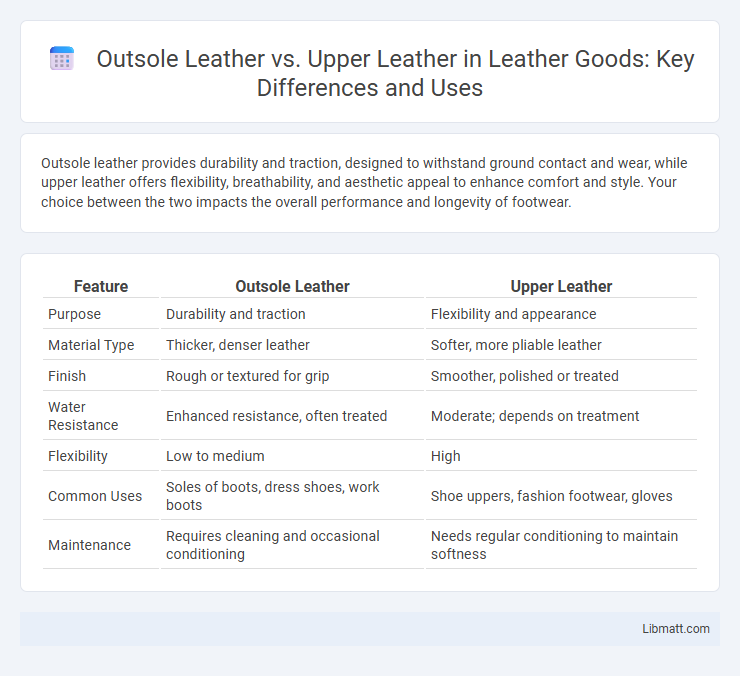Outsole leather provides durability and traction, designed to withstand ground contact and wear, while upper leather offers flexibility, breathability, and aesthetic appeal to enhance comfort and style. Your choice between the two impacts the overall performance and longevity of footwear.
Table of Comparison
| Feature | Outsole Leather | Upper Leather |
|---|---|---|
| Purpose | Durability and traction | Flexibility and appearance |
| Material Type | Thicker, denser leather | Softer, more pliable leather |
| Finish | Rough or textured for grip | Smoother, polished or treated |
| Water Resistance | Enhanced resistance, often treated | Moderate; depends on treatment |
| Flexibility | Low to medium | High |
| Common Uses | Soles of boots, dress shoes, work boots | Shoe uppers, fashion footwear, gloves |
| Maintenance | Requires cleaning and occasional conditioning | Needs regular conditioning to maintain softness |
Understanding Outsole Leather and Upper Leather
Outsole leather is designed for durability and traction, typically made from thicker, more robust hides such as full-grain or vegetable-tanned leather to withstand wear and exposure to rough surfaces. Upper leather, in contrast, prioritizes flexibility, comfort, and aesthetics, using softer, more pliable materials like corrected grain or patent leather to mold to the foot and provide breathability. Understanding these distinctions helps in selecting the right leather type for specific footwear functions, ensuring optimal performance and longevity.
Key Differences Between Outsole and Upper Leather
Outsole leather differs from upper leather primarily in durability and treatment, with outsole leather being thicker, more abrasion-resistant, and treated to withstand constant ground contact and moisture. Upper leather emphasizes flexibility, breathability, and aesthetic appeal, often featuring softer, finer grains to provide comfort and style. These functional distinctions define their respective roles in shoe construction, where outsole leather ensures longevity and traction, while upper leather offers fit and visual design.
Material Origins: Outsole vs Upper Leather
Outsole leather is typically made from thicker, more durable hides such as full-grain or top-grain cowhide, chosen for its toughness and resistance to wear from constant ground contact. Upper leather, by contrast, often comes from softer and more flexible materials like calfskin or suede, designed for comfort, breathability, and aesthetic appeal in your footwear. Understanding these material origins helps ensure you select shoes that balance durability with style according to their intended use.
Durability Comparison: Outsole Leather vs Upper Leather
Outsole leather is specifically designed to withstand constant friction and harsh environmental conditions, making it significantly more durable compared to upper leather, which prioritizes flexibility and breathability. Your footwear's outsole must resist abrasion and moisture, while the upper leather focuses on comfort and aesthetics, leading to different durability characteristics. When choosing between the two, understanding that outsole leather offers superior long-lasting protection whereas upper leather requires more care to maintain appearance and structural integrity is crucial.
Functionality and Performance Factors
Outsole leather provides durability, abrasion resistance, and traction essential for ground contact and wear endurance, while upper leather focuses on flexibility, breathability, and comfort to protect the foot and enhance fit. Outsole leather typically incorporates thicker, denser hides treated to withstand rough surfaces and moisture, optimizing performance in rugged conditions. Upper leather leverages softer, more pliable materials that support ventilation and movement, improving overall footwear comfort and adaptability.
Aesthetic Qualities of Outsole and Upper Leather
Outsole leather typically features a thicker, more durable texture with a matte finish designed for rugged wear and grip, enhancing the shoe's functionality while adding a subtle, robust aesthetic appeal. Upper leather offers a smoother, more refined appearance with a polished or semi-gloss finish that highlights craftsmanship and elegance, contributing significantly to the shoe's visual style and sophistication. The contrast between the outsole's utilitarian look and the upper's sleek design creates a balanced aesthetic that appeals to both durability and fashion-conscious consumers.
Maintenance and Care Tips for Each Leather Type
Outsole leather requires regular cleaning and conditioning to prevent cracking and maintain flexibility, especially after exposure to moisture or rough surfaces. Upper leather benefits from gentle cleaning with a damp cloth and the application of leather conditioner to preserve its softness and prevent fading. You can extend the lifespan of both types by storing footwear in a cool, dry place and using protective sprays tailored for leather protection.
Cost Implications: Outsole vs Upper Leather
Outsole leather typically incurs higher production costs due to its thicker, more durable material designed to withstand abrasion and impact, which increases manufacturing complexity. Upper leather, often thinner and more flexible, generally costs less but requires treatment for aesthetics and comfort, influencing its price. The combination of durability needs and aesthetic treatments directly impacts overall footwear pricing, with outsole leather being the costlier component in most high-quality shoes.
Best Applications for Outsole and Upper Leather
Outsole leather, typically made from thicker, more durable types like full-grain or vegetable-tanned leather, is best suited for high-wear areas such as shoe bottoms and soles, providing excellent abrasion resistance and longevity. Upper leather, often softer and more flexible materials like corrected-grain or nubuck, is ideal for the shoe's upper sections where comfort, breathability, and aesthetic appeal are crucial. Selecting outsole leather for rugged use and upper leather for style ensures optimal footwear performance and durability.
How to Choose the Right Leather for Your Shoes
Choosing the right leather for your shoes depends on understanding the distinct functions of outsole leather versus upper leather. Outsole leather needs to be durable, thick, and resistant to wear, often made from full-grain or performance-treated leather to provide traction and longevity. Upper leather should balance flexibility, breathability, and aesthetics, with options like calfskin or suede offering comfort and style tailored to your daily activities and preferences.
Outsole leather vs upper leather Infographic

 libmatt.com
libmatt.com